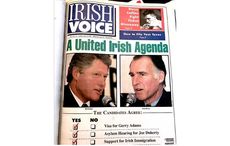If you're going out for a St. Patrick's Day dinner next week, here's something you can do for the homeland. In fact you should consider it your patriotic duty to do this. And as a bonus, you are likely to end up with a meal to remember.
This St. Patrick's Day, forget the bacon and cabbage or, even worse, the corned beef and cabbage that seems to be popular over there as typical Irish fare. Very few people here eat corned beef so I've never understood how it came to be regarded in America as a traditional "Irish" dinner.
Instead of the bacon or the corned beef, give yourself a real treat and order an Irish steak to celebrate St. Patrick's Day this year.
You will be aware, if you have been following the news recently, that Irish beef has been cleared for supply to the U.S. for the first time in over 16 years.
The U.S. ban on beef from this side of the Atlantic began in 1999 following the BSE outbreak in Europe a few years earlier. BSE, commonly known as Mad Cow Disease because of the way infected animals staggered about, was a much bigger problem in the U.K. than in Ireland, with tens of thousands of cases a year there at the peak compared to a few hundred here. It was also a problem in France, Germany and Portugal, among other European countries.
But although the outbreak in Ireland was relatively small compared to the U.K., thanks to the stringent controls that were quickly introduced here, Ireland was hit the hardest by the bans imposed by importing countries. We are a beef exporting country with 90 percent of the beef we produce being exported, so the impact here was serious.
The number of cases In Ireland quickly declined to tens a year and then to a handful. And we have been completely BSE free here now for the past few years.
The campaign to convince the American authorities that Irish beef is safe to eat intensified over the last two years, and at last we have been given the all clear. In fact Ireland is the only EU member state now approved to export beef to the U.S. market.
The Irish Minister for Agriculture Simon Coveney was over there recently on a four-day tour of New York, Washington, D.C. and Boston to help in the promotion of Irish beef and draw public attention to the fact that it was now going to be available in the U.S. again. He was accompanied by a big delegation from the Irish beef industry, there were demos by top chefs in the best restaurants and steak houses, and a presentation in the Irish Embassy. The emphasis was on Irish beef as a premium product, natural and grass fed, with unrivalled taste and quality.
As I understand it, the Irish beef is being distributed by the U.S. food distribution giant Sysco and initially will be supplied to steak houses and restaurants on the East Coast before it arrives in cities across the rest of the U.S. The expectation was that it would be appearing on menus in New York, Boston and Washington in time for St. Patrick's Day.
Which brings us back to your patriotic duty. Ask specifically for Irish steak in your favorite restaurant this St. Patrick's Day and if it's not available, tell the manager that he needs to get on to Sysco and hurry up the process. Consumer demand is what will make this happen quickly and all of you over there have a part to play in that.
This is not just a matter of waving the green flag. You should order Irish steak simply because it is the best there is. Nothing compares to the taste of natural, grass fed, Irish beef, pure and free from hormones, antibiotics and growth promoters.
The taste and quality of Irish beef comes from our unique position on the edge of Europe, which makes us the best country in the world for grass growing and beef production. Ireland is lapped by the gulf stream so the climate is temperate and the prevailing winds bring us endless clouds which have picked up loads of moisture crossing the Atlantic. So it rains here a lot and as a result the grass here -- all 40 shades of it -- grows almost the whole year round.
Even when farmers here bring cattle inside in the middle of winter, they are fed on silage (fermented grass), with some extra grain rations. It's all natural and Irish cattle spend most of their lives outdoors feeding on fields of fresh rich grass. The contrast with American beef is stark.
Many years ago I drove across the U.S. from Washington, D.C. to Los Angeles, delivering a car for an auto driveaway company that moved cars from one side of the U.S. to the other for owners too busy to drive themselves (it was a popular thing for Irish students to do at the time).
It was a great way to see the U.S. and I got off the interstates regularly to sample the "real" America, which is how I ended up one day at a huge feedlot somewhere in Oklahoma or the Texas panhandle.
It might seem like an odd thing to do, but being from a farming background I was interested. The scale of the feedlot was incredible, thousands and thousands of cattle in dusty pens on hardened ground with not a blade of grass in sight. And the pens went on and on as far as the eye could see.
Talking to the folks who worked there, I discovered that the cattle were being fed a diet of genetically-modified corn, cheap roughage like corn stalks, fats and by-products rendered from other animals, and mixes of vitamins and drug additives like antibiotics and growth hormones. It was industrial farming on a scale I had never seen before.
In comparison with this system -- and I doubt if much has changed over the years -- the way Irish beef is produced is a kind of natural perfection.
Grass-fed beef is unbeatable for taste, flavor and healthy goodness. And it's not just the nutrients in the grass that are important. Grazing lush fields of grass where cattle have freedom to move around means the animals have less stress, and the experts tell us that this also improves the taste balance and quality of the meat.
There is a movement here now to have beef that comes from different parts of Ireland recognized as distinctive in the same way that French wines that come from different terroirs are recognized as having different characteristics. That may be some way off yet, although it's not as far fetched as it seems.
Some steak eaters here I know already claim to be able to tell what part of the country their steak has come from (like a slightly salty tang indicating beef from Connemara on the west coast).
The first Irish beef that will be served up this month in the U.S. will be premium steak cuts and possible other choice cuts, not ground beef for hamburgers. But there are ongoing negotiations between the U.S. and Irish authorities which may allow the importation of Irish ground beef as well in the coming months.
If so it is likely to be high quality. There is already a strong demand here for what are called "gourmet burgers" made with the finest ground beef, and that could be replicated with Irish beef in the U.S.
The Irish steaks in the U.S. won't be cheap because Irish beef is a premium product. But discerning Irish Americans will probably be willing to pay a little extra for the quality.
Like consumers everywhere, they have a growing awareness of the importance of what they are eating. They will also be aware that Irish beef is produced from the most natural and environmentally sustainable system in the world.
The Americans are not the only ones waking up to the desirability of Irish beef. The past few weeks have also seen a new agreement with China, where European beef had also been banned, to allow the importation of Irish beef.
The new wealthy of China have developed an appetite for premium imported products like designer clothes, cars and whisky, and Irish beef is now seen as part of that mix. Irish butter is already very popular in China.
However, renewed access to the U.S., the largest food market in the world, is by far the most exciting thing to have happened to Irish beef this year. The potential is huge, because U.S. beef prices are currently high and the U.S. consumes around 25 billion pounds of beef a year, 10 percent of which is imported.
Or to put it another way, each year the U.S. imports twice as much beef as the total beef production of Ireland!
There is no reason why Irish beef should not soon be regarded across the U.S. as the premium beef that top end steak houses, restaurants and gourmet food stores offer as the best meat they have. The quality of Irish beef deserves nothing less.
Bu first we have to spread the word. Which brings us back to your patriotic duty.
Get out there this St. Patrick's Day and loudly and proudly order Irish steak. You'll have a superb dinner!




Comments